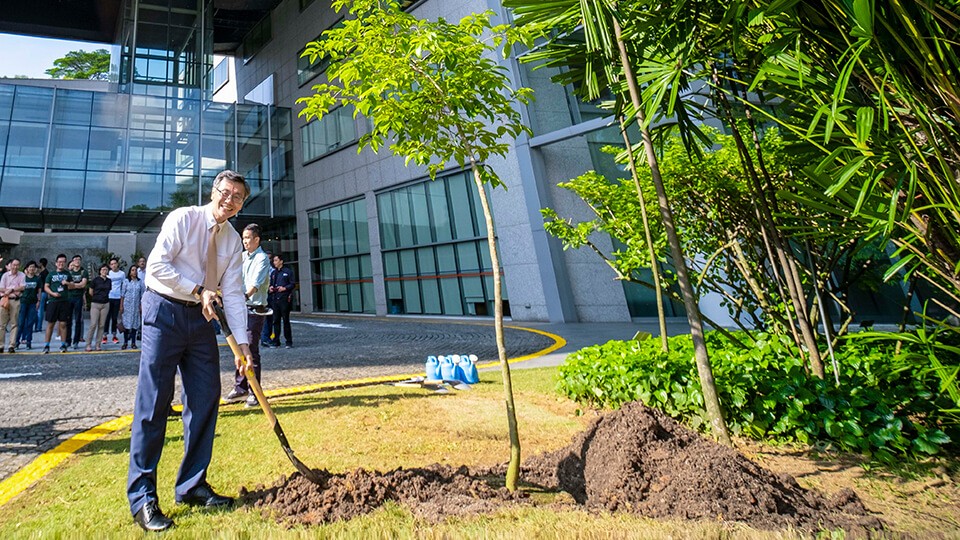Greening our campus
Emphasising the University’s commitment to preserving Singapore’s rich biodiversity, fighting climate change and being an environmentally responsible campus, NUS President Professor Tan Eng Chye launched the “Planting 10,000 Trees” initiative at University Hall on 23 November, in line with National Tree Planting month.
The initiative, which continues Singapore’s significant and time honoured tradition of tree planting started by founding Prime Minister Lee Kuan Yew, will see 500 mature trees planted throughout the campus, as well as 9,500 saplings nurtured in the NUS nursery. This will include both native and common species found in Singapore, along with endangered species such as the Margaritaria indica. To protect the habitats of these trees, a strict NUS tree protection policy will be put in place.
“The benefits of cultivating a rich and diverse landscape of trees and plants extend beyond providing shade and visual aesthetics. Regular exposure to them can have a positive effect on cognitive and emotive wellbeing, and promote social interactions. These are desirable attributes as we seek to be a world class institution of learning, intellectual dynamism and also rich social networks,” said Prof Tan at the launch.
The “Planting 10,000 Trees” initiative will harness the expertise of NUS researchers and smart technology in its greening efforts. Led by NUS Facilities Management and the Green Spaces Task Force under the NUS Sustainability Steering Committee, urban heat maps collected from thermal satellite images generated by NUS Design and Environment researchers will help to identify ideal planting locations throughout the campus. By shading heat-absorbing surfaces and mitigating the urban heat island effect, the trees are expected to cool down surrounding temperatures by about one degree Celsius, as well as contribute to the sequestration of 220 tonnes of carbon dioxide and the production of nearly 1,200 tonnes of oxygen annually.
Each new tree will be tagged and captured in a Geographical Information System (GIS) database with its own unique identity and coordinates. The database will compile information on tree health and inspection, and facilitate effective tracking and study of the trees across their full life span of up to 40 years.
The benefits of cultivating a rich and diverse landscape of trees and plants extend beyond providing shade and visual aesthetics. Regular exposure to them can have a positive effect on cognitive and emotive wellbeing, and promote social interactions. These are desirable attributes as we seek to be a world class institution of learning, intellectual dynamism and also rich social networks.
The new initiative builds on the Campus Greenery Plan introduced by the then Office of Estate & Development in 2012 which aimed to envelope campus buildings in a “tropical rainforest” to enhance the wellbeing of the NUS community while retaining biodiversity. Over the next few years following its introduction, more than 2,000 new trees and shrubs were planted, 33,000sqm of skyrise greenery was incorporated into 30 buildings, and 6,500 trees were inventorised using GIS.
Going forward, under the new three-year Campus Greenery Plan, also launched on 23 November, NUS plans to work with urban greening specialists to create three clusters of urban farms at Prince George’s Park bungalows, Kent Ridge Road bungalows and NUS Science, and a further 20 green roofs and vertical green walls to reduce the “greyness” of buildings on campus. Smart technologies such as special lamps which promote the growth of green walls in enclosed spaces, improved auto-irrigation systems, and drones for fauna health inspection, will also be utilised in support of the efforts.
Prof Tan said that the University hopes to involve different segments of students, staff, faculty and alumni in carrying out its ambitious greening plans. “For all of us who are part of the NUS community, I am glad we can look forward to a lush, lovely and leafy campus that is conducive for life, work and play,” he added.





